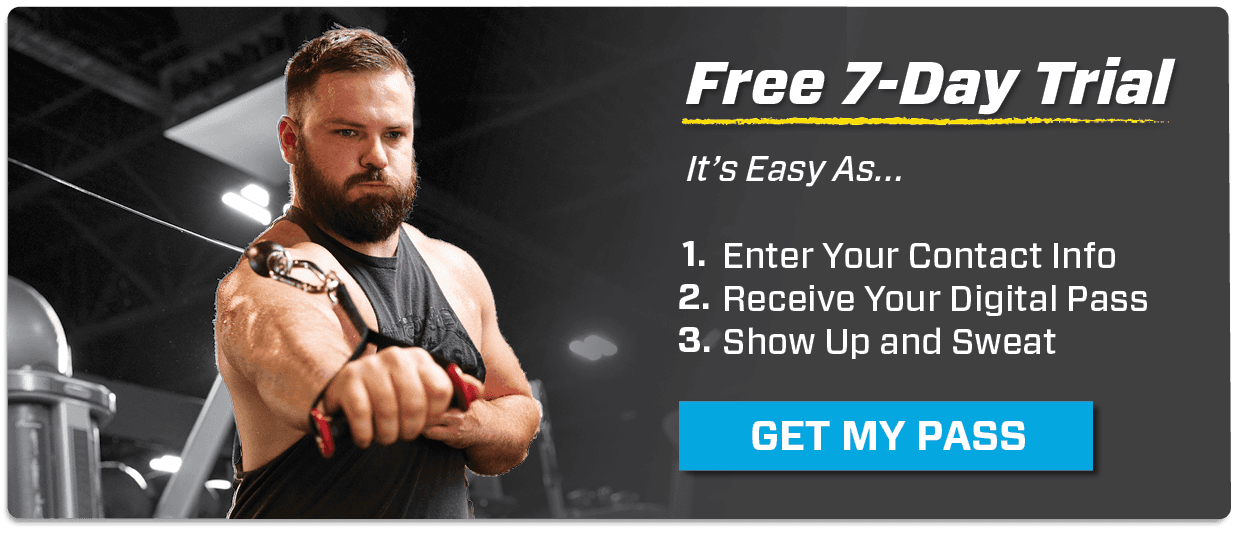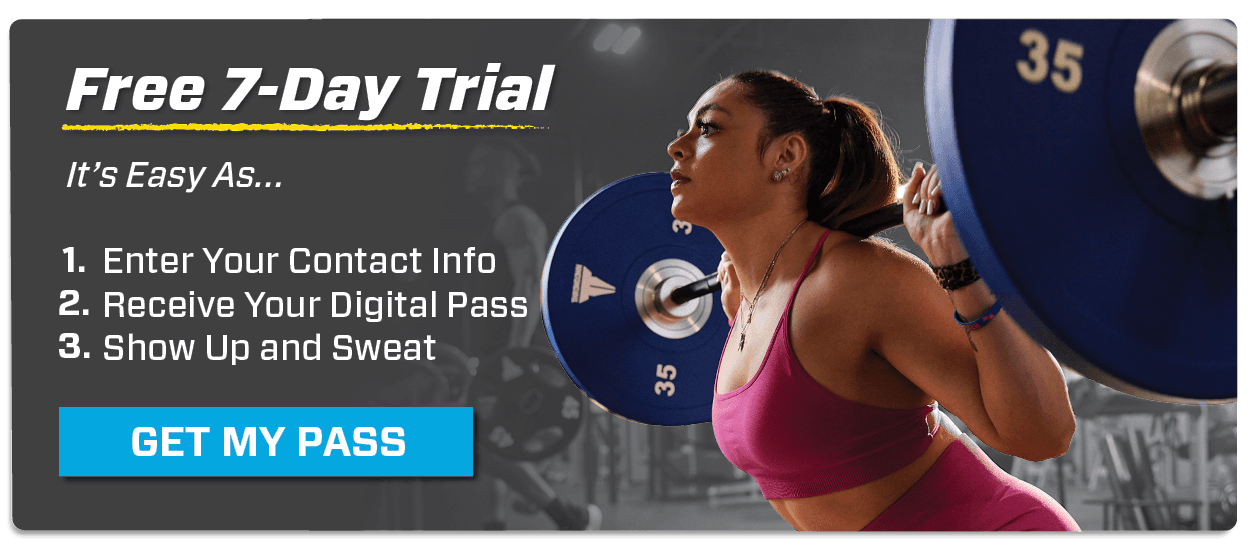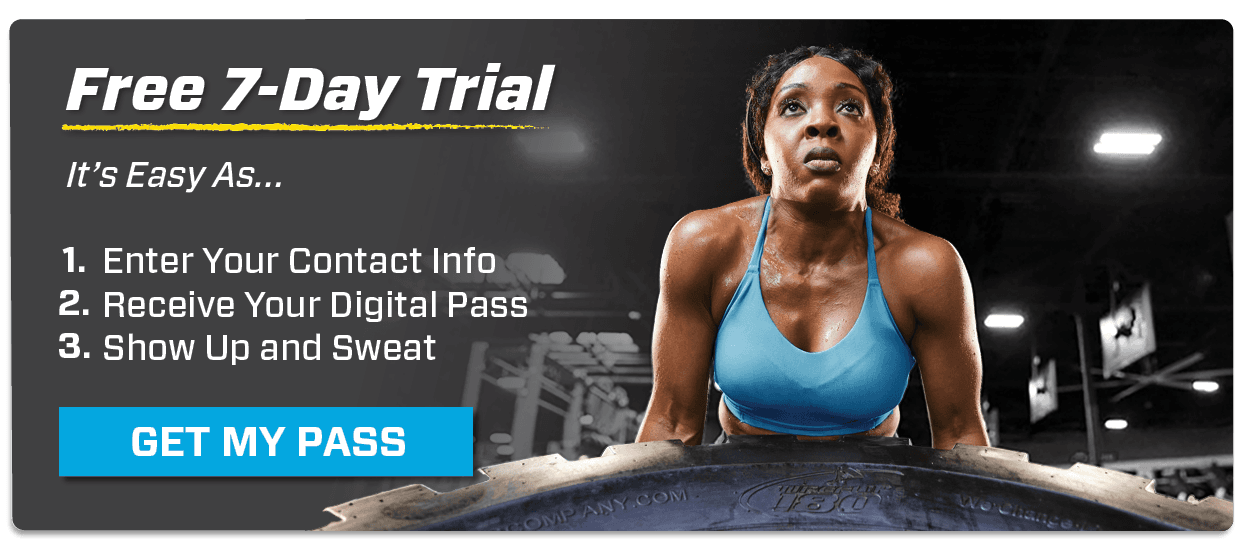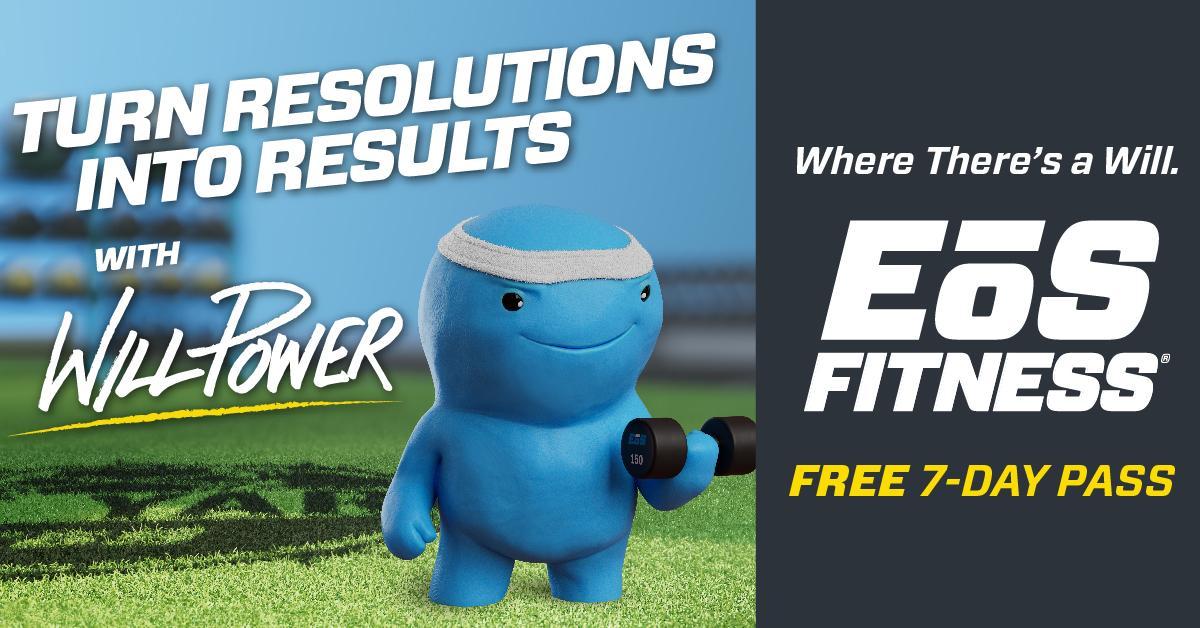10 Exercises To Add To Your Upper Body Free Weight Workout
Fitness Tips
Aug 17, 2023 • 10min read
It’s great to use the resistance machines at your gym to strength train and build muscle mass. However, if you want to add a new challenge to your upper body workout routine, then it’s time to add on some free weight upper body exercises!
Free weights are a type of exercise equipment consisting of individual weights, not attached to any machinery or apparatus. Unlike machines that guide your movements, free weights offer a more versatile and dynamic workout experience. They come in various forms, such as dumbbells, barbells, kettlebells and weight plates. If you want to learn more about the different equipment and their benefits, check out our guide to using different gym equipment.
THE BENEFITS OF DOING YOUR UPPER BODY WORKOUT WITH FREE WEIGHTS
Using free weights – meaning dumbbells, kettlebells and barbells — offers amazing benefits that can boost your overall fitness and strength. When you do an upper body workout with free weights, you’ll feel a sense of freedom and control while engaging multiple muscle groups all at once, which helps build functional strength.
One of the coolest things about free weight upper body exercises is how they activate your stabilizer muscles. Unlike machines that guide your movements, free weights require you to stabilize the weights throughout the entire range of motion. This not only makes you stronger but also improves your balance and coordination. Plus, using free weights lets you move through a wider range of motion, which can help with flexibility and mobility.
Free weight exercises also help you gain functional strength, making everyday tasks like lifting heavy items feel much easier! So, if you’re looking to take your workouts to the next level and see some real-life benefits, give those free weights a try – you won’t be disappointed!
How exactly do you perform an upper body free weight workout? See below for a list of free weight exercises for your arms, chest and upper back along with variations suitable for all fitness levels. (Before you start using free weights, make sure you don’t fall for any weightlifting myths!)
HOW TO GET STARTED WITH AN UPPER BODY FREE WEIGHT WORKOUT
Getting started with free weights is a fantastic way to level up your workout routine. If you’ve never worked with free weights before, it’s important to keep a few things in mind:
- Choose The Right Weights: If you’re new to free weights or are trying an exercise you haven’t done before, start with lighter weights to get the hang of the movements and reduce the risk of injury. You can always increase weight gradually as you gain confidence and strength.
- Ensure Proper Form: Before adding weight, practice the correct form for each exercise. This ensures you perform the movements safely and effectively. You can start with bodyweight exercises to get comfortable with the motions.
- Start With Basic Exercises: Focus on fundamental free weight exercises that target major muscle groups. Some great ones include squats, lunges, deadlifts, bicep curls, tricep dips and shoulder presses. These exercises provide a solid foundation for your strength training.
- Be Safe: Any time you push free weights overhead, make sure to have a spotter standing by.
SOME OF THE BEST UPPER BODY FREE WEIGHT EXERCISES TO TRY
1. BICEP CURLS
Works: Biceps
Perform: Three sets of eight reps, alternating on each arm
You’ve probably seen plenty of people at the gym doing this free weight arm exercise. While you can do this movement sitting down, you can also try standing up so that you can activate your core during the movement.
Start with a medium-weight dumbbell in one hand, hanging at your waist with your palms facing forward. Tighten your core, and using only your biceps, curl the weight up toward the front of your shoulder. Hold for one second at the top, then lower in a slow, controlled fashion. Switch to the other arm and repeat after each set.
Alternatives: You can switch out the dumbbells for small kettlebells or even perform this movement with an EZ curl bar, which is a short, curvy barbell. If you use an EZ curl bar, you will not need to alternate. Instead, lift the bar with both arms and complete three sets of eight reps.
2. DUMBBELL SHOULDER PRESS
Works: Shoulders, triceps
Perform: Three sets of eight reps
Bring two medium-weight dumbbells into the front-rack position, meaning you hold them at the level of your collarbone. Your knuckles should face toward your body. Keep your elbows down and your gaze forward. Tighten your core and without moving your lower body, use your shoulders to press the dumbbells straight overhead until your arms are fully extended. Bring them down slowly in a controlled manner.
Alternatives: To make this movement easier, focus on working one arm at a time or use a barbell instead of dumbbells. To make the movement harder, use kettlebells.
3. KETTLEBELL FARMER’S WALK
Works: Shoulders, traps, forearms, glutes, quads, hamstrings and core
Perform: Three sets of 20 to 30-second walks with 30-second rest between sets
The kettlebell farmer’s walk is a great functional exercise that not only targets the muscles mentioned above but also helps improve grip strength, cardiovascular endurance and overall stability. To start, find an open lane of space in your gym or home. Pick up a medium-weight kettlebell by the handle in each hand and begin walking. Keep your shoulders back and down (not hunched) and your gaze forward. Use your core strength to stabilize the kettlebells, avoiding any swinging motion. Set them down gently between each set. As much as you may be tempted to drop them, you could damage the floor or injure yourself!
Alternatives: You can also use dumbbells instead of kettlebells.
4. DUMBBELL TRICEPS KICKBACK
Works: Triceps, shoulders
Perform: Three sets of eight reps on each arm
To make the most out of this free weight arm workout, use a bench or chair and choose a lightweight dumbbell. Place your left hand and left knee on the bench or chair. Your left arm should be straight. Pick up the dumbbell in your right hand. Pull your right elbow back so that the dumbbell hovers around your ribcage. Keeping your body tight and still, extend your right arm behind you at the elbow, using your triceps muscle to move the weight. Pause for one second with your arm extended, then slowly bend your elbow to return to the starting position. Switch sides between sets.
Alternatives: To make this movement more difficult, use a small kettlebell.
5. DUMBBELL BENT-OVER ROWS
Works: Back, biceps
Perform: Three sets of six to eight reps
This is an excellent free weight back exercise to strengthen your upper back. Choose a pair of medium-to-heavy dumbbells. Start with your feet hip-width distance apart and a dumbbell in each hand. Hinge forward at the hips while keeping your back flat. Keep your knees slightly bent. Tighten your core and pull the dumbbells toward your ribcage. Focus on activating your lats. It may help to imagine you have a set of wings on your back, and you’re squeezing them together at the top of the movement. Hold for one second, then slowly lower the dumbbells.
Alternative: You can also use kettlebells or a barbell for this movement. If using a barbell, you can either have your hands in a pronated (palms facing down) or supinated (palms facing up) position.
6. KETTLEBELL BENT-OVER FLIES
Works: Rear shoulders, upper back
Perform: Three sets of six reps
This exercise attacks and strengthens your lats from a different angle than the bent-over rows, putting emphasis on different parts of the muscle. It’s also an excellent free weight back exercise.
Choose a pair of light-to-medium weight kettlebells and hold them by the handles in each hand. Start in the same position as the bent-over rows. However, instead of pulling your kettlebells to your ribcage, you’ll extend your arms out to the sides. Keep your core engaged and pull with the muscles of your upper back, rather than your shoulders.Hold at the top for a second before bringing your arms down in a controlled manner. The kettlebells will make this movement feel a little unwieldy, forcing you to work on balance and body control. (Check out five great full-body kettlebell workouts.)
Alternatives: To make this movement easier, use dumbbells instead of kettlebells.
7. BARBELL BENCH PRESS
Works: Chest, shoulders, triceps
Perform: Three sets of six reps
The ultimate free weight chest exercise is the bench press. This movement requires balance and technique, so it’s a good idea to practice with an empty barbell before adding weight. Place a flat bench under a barbell rack. The bench should be low enough that you can keep both heels on the ground during the movement (add weight plates under your heels if you can’t reach the floor). Set the bench so that the barbell is at your eye line. Grip the bar roughly shoulder-width apart.
Press the bar up and forward out of the rack. Slowly, bring the bar down so it is in line with the bottom of your pecs, just above your rib cage. Keep your elbows back and slightly out. Now, use your chest muscles to press the bar back up. Try not to let your hips come off the bench.
Always use a spotter on your bench press.
Alternatives: You can also use dumbbells or kettlebells to perform the bench press.
8. DUMBBELL CHEST FLY
Works: Chest, front shoulders
Perform: Three sets of six reps
If you’re looking for another free weight chest exercise, the dumbbell chest fly is a great option. While the bench press is a compound movement that recruits help from the shoulders and back, dumbbell chest flys depend almost entirely on your chest muscles.
Choose a pair of light-to-medium-weight dumbbells. You can either lie on a flat bench or use an inclined bench. Begin the movement with the dumbbells held out in front of you, just like you would a barbell for a bench press, but with your palms facing toward each other. Slowly bring your arms out and down to each side. Control the dumbbells. If they are wobbling in the early reps, you’re using too much weight. Do not let your arms extend fully by keeping a slight bend in each elbow. At the bottom of the movement, use your chest muscles to press the weight back up to the center of your chest. It is also a good idea to use a spotter on this movement.
Alternatives: To make this movement more difficult, switch out your dumbbells for kettlebells.
9. BARBELL PUSH PRESS
Works: Shoulders, chest, triceps
Perform: Three sets of six to eight reps
Push presses are a great way to add explosive movements to your free weight arm workout and to recruit muscles in your lower body to help with this movement. Add a medium amount of weight to the barbell. If you are proficient with cleans, you can power clean the bar into the front rack position. If not, set a barbell rack so that you can lift the barbell from the rack for each set. Stand with your feet hip-width apart. Your elbows should be down and slightly forward.
Push your hips back and bend your knees, just as if you were going to start a squat. Driving your heels down and engaging your glutes, explode up, using your arms to push the barbell up and overhead. Make sure to pull your head back to avoid the bar as it comes up and then push your head “through the window” when the weight is overhead. Bring the barbell back down in a controlled manner to the front rack and repeat. When you become comfortable with this movement, try to cycle the push presses with no pauses between reps.
Alternatives: You can perform the push press with dumbbells or kettlebells to make the movement more difficult.
10. OVERHEAD KETTLEBELL LUNGES
Works: Shoulders, forearms, traps, quads, glutes and core
Perform: Three sets of 20 reps (ten on each leg)
Sometimes you don’t have enough time to focus on a single part of the body. In these instances, compound movements can help you save time by working multiple muscles all within one movement. One example of a compound movement that combines a free weight arm exercise with a free weight leg exercise is the overhead kettlebell lunge.
Choose two light or medium-weight kettlebells and hold them at the top of each handle with the bell resting across the back of each forearm. Bring them to the front rack and use a push press or shoulder press to lift them overhead. Keep your arms locked out overhead and as close to your ears as possible. Tighten your core and lunge forward. You can either perform a walking lunge or lunge in place. If you begin to lose control of the dumbbells, choose a lighter weight for your next set.
Alternatives: To make this movement easier, you can switch the kettlebells for dumbbells. You can also hold a single kettlebell by the bell, a single dumbbell or a weight plate overhead.
GET STARTED WITH YOUR UPPER BODY FREE WEIGHT WORKOUT
These are just a few examples of free weight exercises for the upper body, but they are a great start to incorporating free weights into your fitness routine. Free weights are also excellent for the lower body, so make sure to check out our lower body free weight blog for lots of lower-body exercises that will challenge you.
If you feel unsure about using free weights on your own, consider joining a strength-training Group Fitness Class at your gym. These strength-based Fitness Classes often incorporate dumbbells, weight bars and other free weights. You can also invest in a Personal Trainer. Your Personal Trainer can help you learn the right form for free weight exercises and show you many different free weight options. Now, go get lifting!








